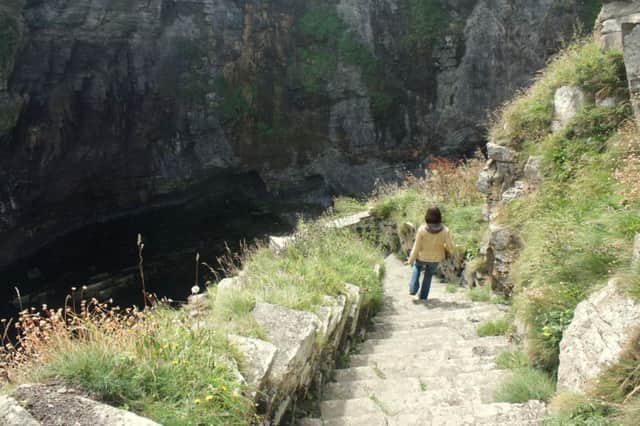Scottish fact of the week: Whaligoe Steps


The Whaligoe Steps, on Scotland’s most northeasterly coast, is a man-made stairway of between 330 and 365 flagstone steps, leading to what was originally a landing place for fishing boats - Whaligoe Haven.
Its name is thought to derive from the word ‘goe’ - a rocky inlet surrounded by cliffs - and a dead whale that washed ashore at the harbour at some point in history.
Advertisement
Hide AdBuilt sometime in the 1700s, the steps were once used by fisherwomen to carry creels of fish from the vessels landing at the harbour below. Thomas Pennant, who visited the area in 1769, made reference to the locals using steps to carry heavy loads, so it seems likely that they were built in the mid-18th century.
Vast numbers of women, some in their seventies, would collect the catch, gut the fish - herring, cod, haddock or ling - and would haul them up the stairs in baskets, to be taken on foot to Wick.
A cooperage at the top of the stairs made barrels which were then taken down to the harbour so that salted herring could be stored, before being transported by ships to their next destination.
In 1808, seven fishing boats worked Whaligoe. By 1826, that number had increased to 24, although it declined rapidly in the following years, with fewer ships using the harbour.
By 1920, just five boats remained, fishing for salmon and by 1946, this number had fallen to two boats, with the last calling a day on fishing from Whaligoe in the 1960s.
Still a popular attraction today, the Whaligoe Steps are notoriously difficult to locate. They are not signposted from the main road, but can be found close to the village of Ulbster, just off the A99.
Advertisement
Hide Ad(Hint: keep an eye out for the crossroads where a sign points to the Cairn o’Get monument. Take the road opposite past a row of fishermen’s cottages until you come to a tarmac parking area).
It is a worthwhile effort, however, as the bottom of the steps leads to the naturally-formed harbour, nestled between two 250ft-high sea cliffs, with hordes of birds such as terns and oystercatchers nesting in the cliffs.
Advertisement
Hide AdAt the bottom of the steps is a man-made grassed area, known as the Bink. The size of a narrow tennis court, one end of the Bink is home to a ruined building once used to store the salt for curing fish.
Originally mid-18th century, the steps have been repaired twice; once in the early 19th century and again more recently, but the current configuration is believed to date back to 1792.
Renowned engineer of the early 1800s Thomas Telford described Whaligoe as a ‘dreadful place’ during his work on harbour and piers in Scotland.
In 1975 Etta Juhle, a local, shifted around 30 tons of rubble alone following a landslip, while David Nicolson, of Ulbster, has worked tirelessly on the steps with historian Iain Sutherland, and several other volunteers since 1998.
Tasks undertaken include repairing the ‘barking kettles’ (used for heating up tar for waterproofing nets and boats), quarrying, and manually carrying stone up and down the cliffs, and cutting the grass at least once a month during the summer season.